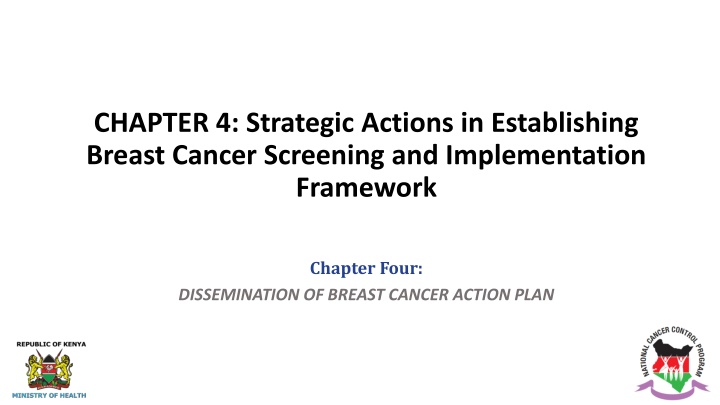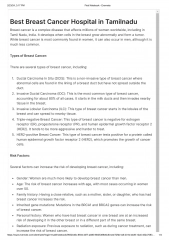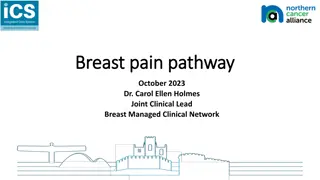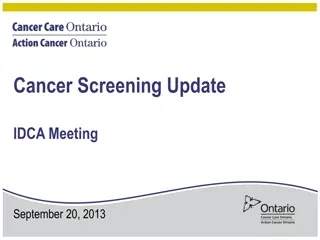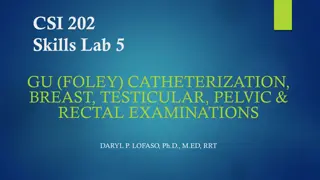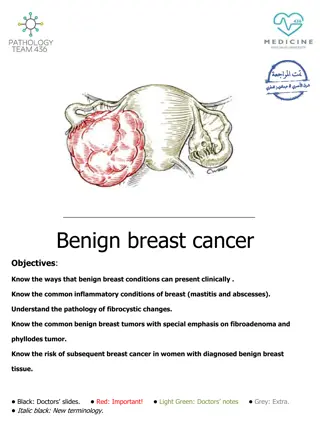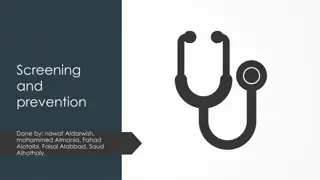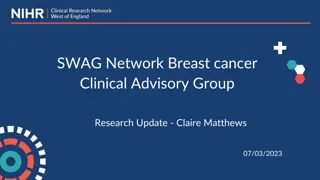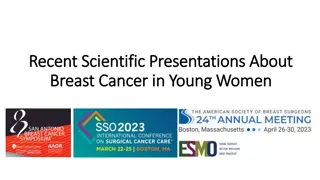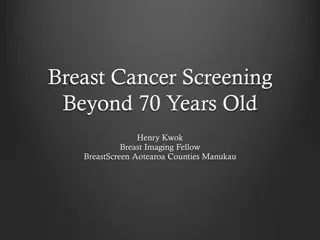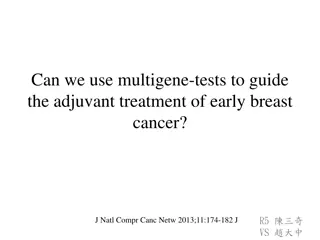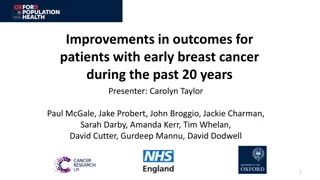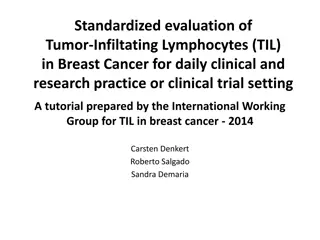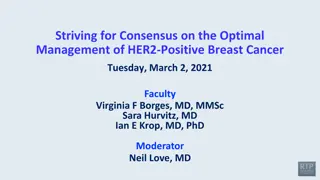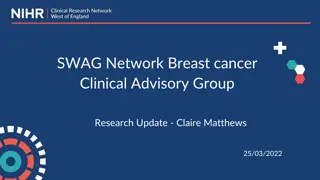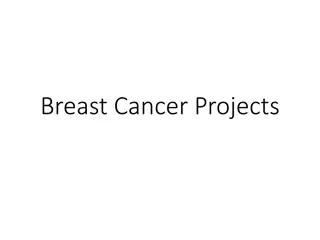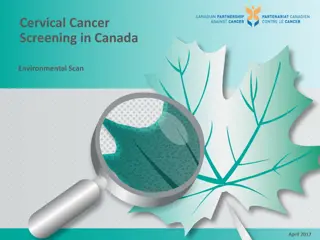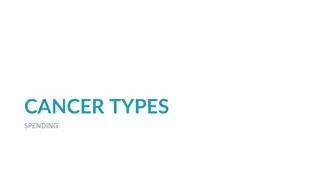Comprehensive Framework for Breast Cancer Screening Implementation
This chapter outlines the strategic actions and essential supply needs for establishing a breast cancer screening and early diagnosis service. It covers ISO 9001:2015 certified procedures, human resource requirements, rapid diagnostic clinic setup, necessary medical devices, and planned implementation activities. The focus is on ensuring efficient and effective breast cancer screening to improve early detection and treatment outcomes.
Download Presentation

Please find below an Image/Link to download the presentation.
The content on the website is provided AS IS for your information and personal use only. It may not be sold, licensed, or shared on other websites without obtaining consent from the author.If you encounter any issues during the download, it is possible that the publisher has removed the file from their server.
You are allowed to download the files provided on this website for personal or commercial use, subject to the condition that they are used lawfully. All files are the property of their respective owners.
The content on the website is provided AS IS for your information and personal use only. It may not be sold, licensed, or shared on other websites without obtaining consent from the author.
E N D
Presentation Transcript
CHAPTER 4: Strategic Actions in Establishing Breast Cancer Screening and Implementation Framework Chapter Four: DISSEMINATION OF BREAST CANCER ACTION PLAN
OUTLINE ISO 9001:2015 Certified Establishing a Breast Cancer Screening and Early Diagnosis Service Essential supply needs for screening & early diagnosis service provision Essential Human Resource Needs for Breast Cancer Screening Rapid Diagnostic Breast Clinic for Symptomatic Women Medical Devices for Breast Cancer Surgery Planned Activities Key Result Areas Implementation Matrix
Essential Supply Needs for Breast Cancer Screening & Early Diagnosis Service Provision ISO 9001:2015 Certified 1. CBE Screens for privacy Water & soap for handwashing/ sanitizer Clean gloves Examining table and bed-spread (consider disposable sheet cover roll) Adequate lighting Job aid Stationery
Essential Supply Needs for Breast Cancer Screening & Early Diagnosis Service Provision Cont d ISO 9001:2015 Certified 2. Mammography: Fixed or mobile digital mammography unit. Appropriate room with radiation protection measures. Patient privacy: secure exam rooms, gowns, private dressing room and closet. Reading room: dedicated areas to interpret mammograms. Electric supply (with back-up system) Appropriate waste disposal and ablution. Disinfection/infection prevention and control: handwashing, cleaning, sanitizers. Proper storage and preservation of images or films* PAC system with digital scanners for tele-reporting. Compression devices for additional projections.
Essential Supply Needs for Breast Cancer Screening & Early Diagnosis Service Provision Cont d ISO 9001:2015 Certified 3. Other Breast Cancer Devices and Accessories Procedure Capital Equipment Stereotactic guided core needle biopsy of primary tumor or metastatic lesions Mammographic stereotactic biopsy system (cone compression devices could be used with normal mammographic system) Optional: vacuum-assisted biopsy device and driver. Biopsy gun. Ultrasound probe or transducer/ Linear array, high-frequency transducers, small-footprint, large bandwidth transducers with central frequency above 10 MHz are ideal Ultrasound guided biopsy of regional lymph and sentinel nodes Core needle biopsy Biopsy Gun Fine needle aspiration (FNA) -
Essential Human Resource Needs for Screening ISO 9001:2015 Certified Mammography staff include: a) Radiologist/Interpreting physician a medical doctor with post-graduate training in radiology (where possible, specializing in breast imaging) b) Radiologic technologist: Performs mammographic examinations and prepares films or digitized images for interpretation. Trained and licensed to perform general radiographic procedures. c) Medical physicist: Surveys the mammography equipment and oversees equipment- related quality assurance practices of the facility. d) Radiation protection officer: Ensures that the HCW and the public are protected from the harmful effects of radiation. e) Support staff - clerical staff, data officers and receptionists
ISO 9001:2015 Certified Rapid Diagnostic Breast Clinic for Symptomatic Women Essential staff required to run this Breast Cancer Clinic will include: Administrative/ support staff Nursing personnel Breast clinician Breast surgeon Radiologist with interest in breast imaging Radiographer for imaging procedures Clinical Pathologist Cytologist/Histotechnicians Oncologist
ISO 9001:2015 Certified Key Result Areas 5 thematic areas to achieve Action Plan objectives: 1. Governance And Policy. 2. Demand Creation and Community Education & Engagement 3. Training and Professional Development 4. Service Delivery (Screening, Diagnostics, Patient Navigation & Referral). 5. Monitoring And Evaluation.
ISO 9001:2015 Certified Governance & Policy a) Establish national and county-level breast cancer early detection governance structures b) Identify and sensitize key stakeholders for engagement c) Establish a quality assurance and improvement process within an active screening program to monitor key performance indicators. d) Mobilize resources to support breast cancer screening and early detection programs e) Promote adherence to national clinical guidelines for breast cancer screening, early diagnosis and management
Awareness, Demand Creation and Community Education & Engagement ISO 9001:2015 Certified a) Development, printing and distribution of information, education and communication materials to all health facilities Engage Community Health Volunteers to provide information on breast health and breast cancer awareness through dialogue sessions and other fora Engage & equip key influencer groups (cancer survivors, religious, administrative, community leaders, celebrities, the media/TV personalities and opinion leaders) with advocacy skills for breast cancer awareness Conduct breast cancer screening mobile clinic outreaches in targeted settings Create community to facility linkages for breast cancer further assessment and appropriate referral. Sustained Breast Cancer Awareness campaigns on mainstream, social media and other channels. Institute breast cancer work place programs that encourage early detection of breast cancer b) c) d) e) f) g)
Training/Professional Development of Health Workforce ISO 9001:2015 Certified a) Appropriate training of CHVs, CHEWs and Health Promotion Officers on promoting education of early breast cancer signs and symptoms and risk factors and creating accurate breast cancer awareness. b) Appropriate training of primary care clinicians, family physicians, gynecologists and surgeons on promoting breast health awareness, self-breast examination, conducting CBEs, point-of-care ultrasounds and appropriate imaging referral. c) Appropriate training of imaging personnel on breast imaging techniques including image-guided biopsies. d) Appropriate training of laboratory personnel on handling, processing and interpretation of pathology specimens. e) Training of health records and information officers and other healthcare workers on breast cancer screening data management. f) Integration of breast cancer content in curriculum into Undergraduate and Post Graduate Health Training programs.
Service Delivery (Screening, Diagnostics, Patient Navigation and Referral) ISO 9001:2015 Certified a) Set up Breast Cancer Centers of Excellence (COEs) at the three (3) National referral Hospitals. b) Establish rapid diagnostic units for prompt diagnosis of breast abnormalities in county referral hospitals with provision of histopathology services. c) Establish and strengthen hormonal testing (immunohistochemistry for ER/PR/HER2) for breast cancer at the National Cancer Reference Laboratory, National Referral Hospitals and select high volume county referral facilities with regional cancer treatment facilities. d) Activate breast cancer screening mammography services in the 47 county referral facilities with digital mammogram machines
Service Delivery (Screening, diagnostics, patient navigation and referral) cont d ISO 9001:2015 Certified e) Establish linkages and referral structures (including psychosocial support) for patients and specimens. f) Avail commodities for provision of comprehensive breast cancer services as per level of care g) Develop public private partnerships to provide screening and early diagnostic services. h) Integrate breast cancer screening services to other screening services, including but not limited to maternal and child health, postnatal, HIV and NCDs management
ISO 9001:2015 Certified Monitoring & Evaluation and Research a) Develop a clear Monitoring and Evaluation framework for the breast cancer screening program in Kenya, including awareness, with indicators and suggested data sources. b) Conduct a baseline, midterm and end term assessment of breast cancer screening and linkage to care. c) Strengthen and improve data systems to enable computation and tracking of selected breast cancer screening diagnosis, treatment and follow-up indicators. d) Enhance timely monthly reporting of breast cancer indicators and advocating utilization of this information by all stakeholders, including counties. e) Identify research priority areas and conduct research to guide breast cancer care across the entire continuum
Implementation matrix structure Proposed Activities Sub-activities Key Performance Indicators Responsible Persons 2021 2022 2023 2024 2025 Integrate Breast Cancer Prevention, Screening & Early Diagnosis agenda in the national & county-level committees with representation of relevant stakeholders and experts Sensitization meeting for selected CHMT members and other stakeholders Number of sensitization meetings held MOH-NCI-K, NCCP, counties & other stakeholders X X X X Hold quarterly Breast Cancer TWG committee meetings Minutes of quarterly meetings; Breast cancer TWG X X X X X Implementation of action items Provide technical support on creation & maintenance of county-level committees: membership, TORs & work plans Technical support provided Breast Cancer TWG, Counties X X X X
Summary Take Home Message Essential needs for establishing a breast cancer screening and early diagnosis service include supplies for CBE, mammography, diagnostics & surgery Rapid Diagnostic Breast Clinics are key for symptomatic women Implementation matrix for activities under each key result area outlined with Key Performance Indicators and assigned responsibilities
Thank You! Call to action to beat breast cancer What will you do?
